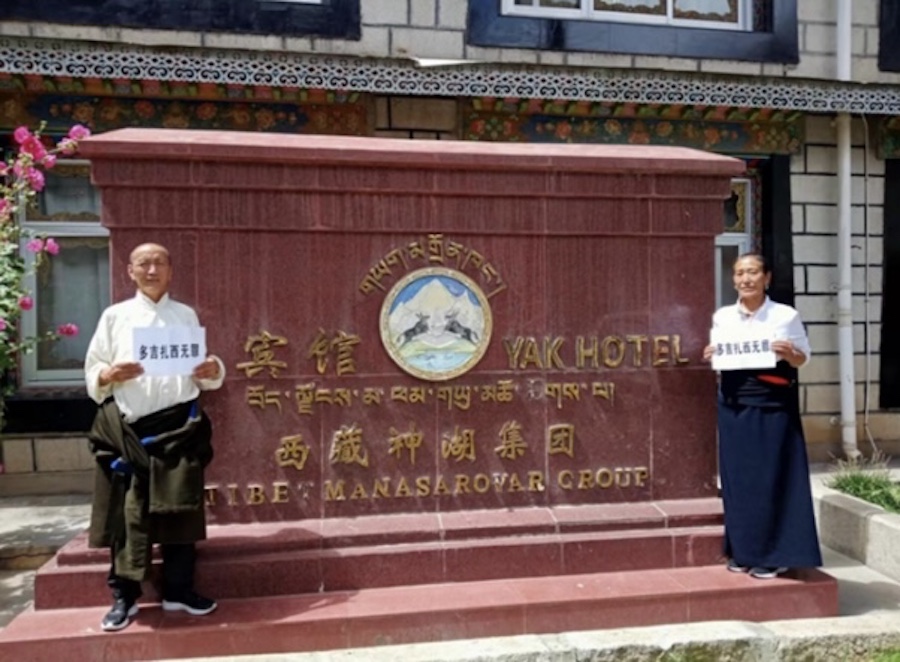When Tibetans moved to India they took their serenity with them, Christina Pfeiffer writes.
 WHEN asked if he misses Tibet, Gyalo Thondup lowers his eyes and sighs wistfully. I’m standing in the courtyard of Darjeeling’s Tibetan Refugees Self Help Centre, a facility set up for Tibetans who followed the Dalai Lama to India in 1959.
WHEN asked if he misses Tibet, Gyalo Thondup lowers his eyes and sighs wistfully. I’m standing in the courtyard of Darjeeling’s Tibetan Refugees Self Help Centre, a facility set up for Tibetans who followed the Dalai Lama to India in 1959.
The site of this charitable organisation, of which Thondup is president, was a gift from the American Emergency Committee and has its own school, dairy, living quarters and workshops.
In the centre’s courtyard, elderly men are gathering bundles of wool to be sent to the spinning factory. A homemade wooden ladder with crooked rungs leans against one of the buildings. On top of the building wool is drying in readiness for the next stage of production.
In return for labour, each member of the centre receives medical assistance, food and pocket money. Although it is a simple existence, the Tibetans I meet seem to have an unshakeable zest for life.
In the spinning room rows of elderly women offer toothy smiles as they feed rolls of wool into a rotating bicycle wheel. With the influx of Tibetan refugees over the years, the centre has grown from just four people to several hundred craft workers, many highly skilled.
However, it’s not only the skilled workers who contribute: the very young and the elderly play their part. The latter perform simple chores such as winding thread into balls and caring for the toddlers in the centre’s nursery.
In the carpet-weaving hall, young women work in pairs fastidiously creating Tibetan carpets. Thick white threads are attached vertically between horizontal wooden poles. The weavers painstakingly tie multicoloured threads around each white strand to produce colourful knots and these are then packed tightly together using a heavy bronze comb.
While the centre’s handicraft shop has a large range of items such as placemats, silk wall-hangings and woodcarvings, handmade carpets are the shop’s most popular item and are exported overseas. The waiting period to obtain one of these labour-intensive works of art is six months.
I’m attracted by the melodious chimes of the solid-brass Tibetan singing bowls. The shop assistant demonstrates the musical resonance of the bowls by running a wooden stick around each rim to produce a different tone.
The song of a mid-sized bowl has me hooked, and as I wait for it to be wrapped, I notice a sign indicating that the 11th Panchen Lama – a Tibetan religious leader second in command to the Dalai Lama- has been held in custody by the Chinese Government since 1995, when he was just six years old. He is believed to be the world’s youngest political prisoner.
As Tibetans are spiritual people it’s not surprising that there are plenty of Tibetan monasteries in Darjeeling. Early one day, at the ungodly hour of four o’clock, I find myself freezing at the lookout on top of Tiger Hill. Unfortunately, the clouds stubbornly refuse to reveal the spectacular view of the mountains at dawn.
On my way back to the town, my driver winds through a narrow street to arrive at the Ghoom monastery, an ancient monastery considered to be one of the holiest in Darjeeling. Outside the monastery Tibetan worshippers spin a long row of prayer wheels then remove their shoes and go inside.
Several winding roads away from Darjeeling towards the nearby hill station of Mirik lies Bokar, a brand new monastery. Golden lions guard the entrance against evil spirits, as do the voices of hundreds of chanting monks.
Peering curiously through the vividly coloured door hangings, I’m surprised when a senior monk waves me in. “Go ahead and take all the photos you want,” he invites, pointing to my camera.
In many Buddhist cultures monks are especially shy of women and hesitant to disrupt their daily prayers. As the institute runs on donations, mainly from France, it’s not so surprising that these monks are accustomed to receiving visitors.
Inside, a giant golden statue of Buddha surrounded by colourful wall-hangings dominates the hall. Two groups of crimson-robed monks sit in cross-legged rows facing each other. The very young novices – some look seven or eight years old – sit at the back staring at me with interest while the senior monks are absorbed in their chanting.
My guide, Mickey, insists we stop for a drop of tongba, a fermented millet drink popular among the Himalayan regions.
We pull up in front of a row of village shops at the India/Nepal border town of Pashupati. The shop owner, a smiley woman in her 30s whose parents fled from Tibet more than 40 years ago, leads us through the shop to her living quarters.
There are two dilapidated single beds with mattresses that have seen better days, a chair and a homemade wooden table.
Giant bamboo mugs filled with dried millet and boiling water are placed in front of us. Chattering away in Tibetan, our host is as excited about meeting me (I’m her first foreign guest) as I am about being in the home of a real Tibetan villager. She disappears into the next room and returns with a pile of traditional Tibetan clothing which she obligingly models for us.
Many photographs and a few mugs later, it becomes clear to me that the Tibetan people in this land have mastered the art of being happy no matter what the circumstances.
I can’t help thinking that it’s an attitude towards life that many of us who live in more sophisticated societies could learn a lot from.
The writer travelled to India as a guest of the Government of India Tourist Office.









